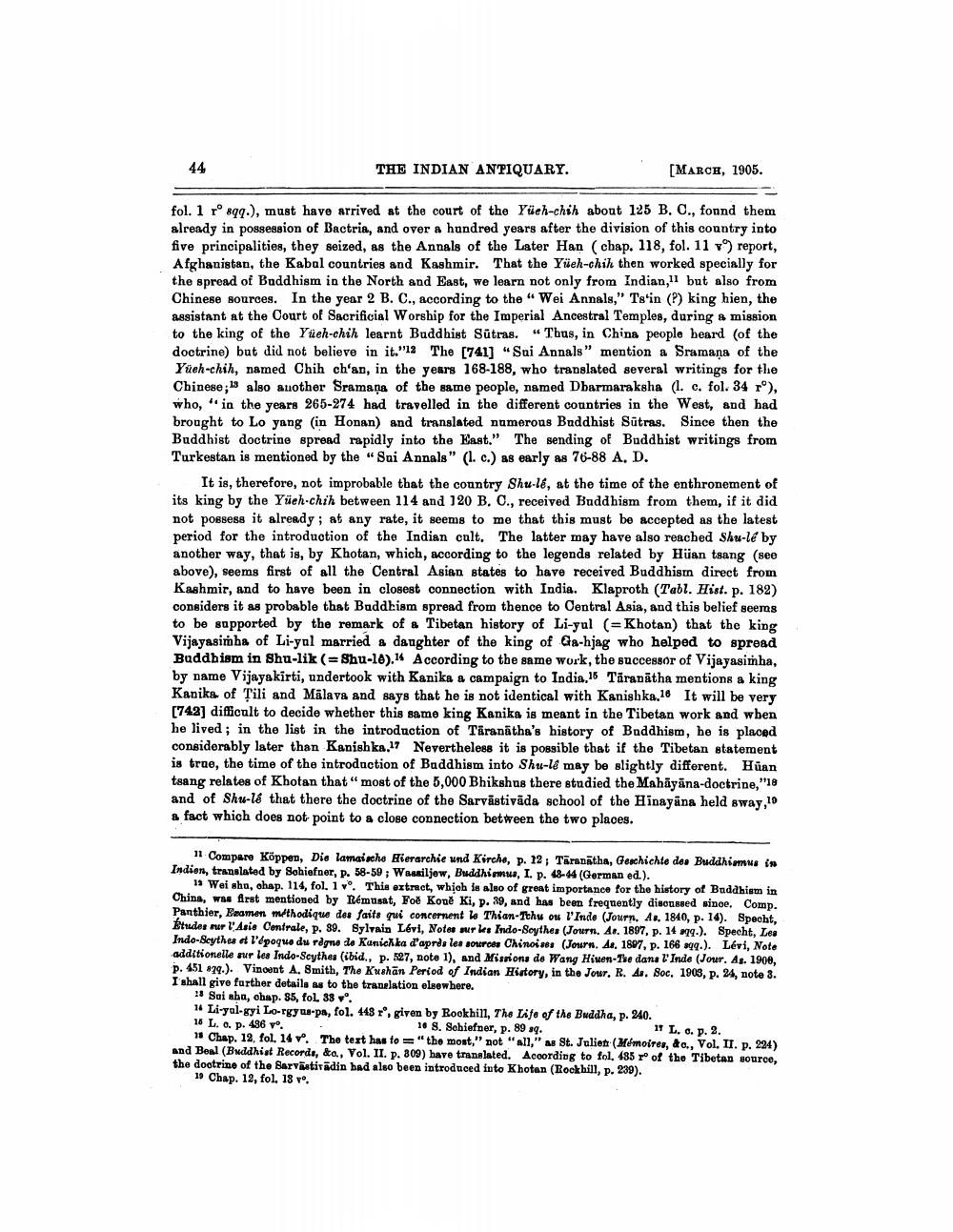________________
44
THE INDIAN ANTIQUARY.
fol. 1 r sqq.), must have arrived at the court of the Yüeh-chih about 125 B. C., found them already in possession of Bactria, and over a hundred years after the division of this country into five principalities, they seized, as the Annals of the Later Han (chap. 118, fol. 11 v) report, Afghanistan, the Kabal countries and Kashmir. That the Yüeh-chik then worked specially for the spread of Buddhism in the North and East, we learn not only from Indian, but also from Chinese sources. In the year 2 B. C., according to the "Wei Annals," Ts'in (?) king hien, the assistant at the Court of Sacrificial Worship for the Imperial Ancestral Temples, during a mission to the king of the Yueh-chih learnt Buddhist Sutras. "Thus, in China people heard (of the doctrine) but did not believe in it."12 The [741] "Sui Annals" mention a Sramana of the Yüeh-chih, named Chih ch'an, in the years 168-188, who translated several writings for the Chinese; 13 also another Sramana of the same people, named Dharmaraksha (1. c. fol. 34 r°), who, in the years 265-274 had travelled in the different countries in the West, and had brought to Lo yang (in Honan) and translated numerous Buddhist Sutras. Since then the Buddhist doctrine spread rapidly into the East." The sending of Buddhist writings from Turkestan is mentioned by the "Sui Annals" (1. c.) as early as 76-88 A. D.
[MARCH, 1905.
It is, therefore, not improbable that the country Shu-lé, at the time of the enthronement of its king by the Yueh-chih between 114 and 120 B. C., received Buddhism from them, if it did not possess it already; at any rate, it seems to me that this must be accepted as the latest period for the introduction of the Indian cult. The latter may have also reached Shu-le by another way, that is, by Khotan, which, according to the legends related by Hüan tsang (see above), seems first of all the Central Asian states to have received Buddhism direct from Kashmir, and to have been in closest connection with India. Klaproth (Tabl. Hist. p. 182) considers it as probable that Buddhism spread from thence to Central Asia, and this belief seems to be supported by the remark of a Tibetan history of Li-yul (= Khotan) that the king Vijayasimha of Li-yal married a daughter of the king of Ga-hjag who helped to spread Buddhism in Shu-lik (= Shu-18).14 According to the same work, the successor of Vijayasimha, by name Vijayakirti, undertook with Kanika a campaign to India.15 Taranatha mentions a king Kanika of Tili and Malava and says that he is not identical with Kanishka.16 It will be very [742] difficult to decide whether this same king Kanika is meant in the Tibetan work and when he lived; in the list in the introduction of Täranätha's history of Buddhism, he is placed considerably later than Kanishka. Nevertheless it is possible that if the Tibetan statement is true, the time of the introduction of Buddhism into Shu-le may be slightly different. Hüan tsang relates of Khotan that "most of the 5,000 Bhikshus there studied the Mahayana-doctrine,"18 and of Shu-le that there the doctrine of the Sarvästiväda school of the Hinayana held sway,10 a fact which does not point to a close connection between the two places.
11 Compare Köppen, Die lamaische Hierarchie und Kirche, p. 12; Taranatha, Geschichte des Buddhismus in Indien, translated by Sohiefner, p. 58-59; Wassiljew, Buddhismus, I. p. 43-44 (German ed.).
13 Wei shu, chap. 114, fol. 1 v. This extract, which is also of great importance for the history of Buddhism in China, was first mentioned by Rémusat, Foě Koně Ki, p. 39, and has been frequently discussed since. Comp. Panthier, Examen méthodique des faits qui concernent le Thian-Tehu ou l'Inde (Journ. As. 1840, p. 14). Specht, Etudes sur l'Asie Centrale, p. 39. Sylvain Lévi, Notes sur les Indo-Scythes (Journ. As. 1897, p. 14 sqq.). Specht, Lea Indo-Scythes et l'époque du règne de Kanichka d'après les sources Chinoises (Journ. As, 1897, p. 166 sqq.). Lévi, Note additionelle sur les Indo-Scythes (ibid., p. 527, note 1), and Missions de Wang Hiuen-The dans l'Inde (Jour. As. 1900, p. 451 429.). Vincent A. Smith, The Kushan Period of Indian History, in the Jour. R. As. Soc. 1903, p. 24, note 3. I shall give further details as to the translation elsewhere.
18 Sai sha, chap. 35, fol. 38°.
14 Li-yal-gyi Lo-rgy us-pa, fol. 443 r°, given by Rockhill, The Life of the Buddha, p. 240. 18 L. c. p. 436 vo.
16 S. Schiefner, p. 89 sq.
17 L. c. p. 2.
18 Chap. 12, fol. 14 v°. The text has to "the most," not "all," as St. Julien (Mémoires, &c., Vol. II. p. 224) and Beal (Buddhist Records, &o., Vol. II. p. 309) have translated. According to fol. 435 r° of the Tibetan source, the doctrine of the Sarvästivadin had also been introduced into Khotan (Rockhill, p. 239).
19 Chap. 12, fol. 18 v°.




